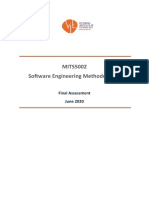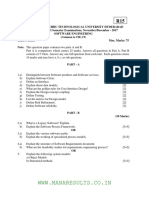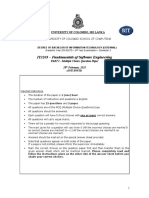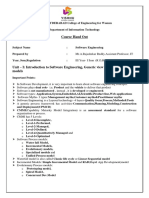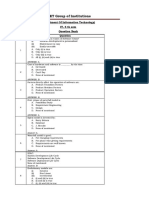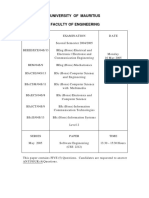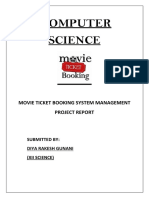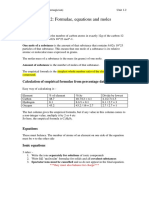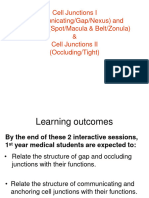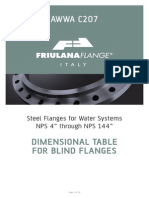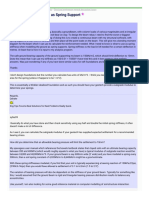BAHRIA UNIVERSITY (KARACHI CAMPUS)
FINAL TERM EXAMINATION – SPRING SEMESTER – 2021
Introduction to Software Engineering (SEN 120)
Objective
Class: BSE 2 (A/B) Morning
Course Instructor: Engr. Mobeen Nazar Time Allowed: 45 Mints
th
Date: 5 July, 2021 Session: II Max Marks: 20
Student’s Name: ____________________ Registration No: _____________
Note:
Write the letters for your answers in the table provided.
Attempt on question paper
FILL IN THE BLANKS ANSWER SHEET MULTIPLE CHOICE ANSWER SHEET
Q. NO. ANSWE Q. NO. # ANSWE Q. NO. # ANSWER Q. NO. # ANSWER
# R R
Q. 1 Q. 11 Q. 1 Q. 11
Q. 2 Q. 12 Q. 2 Q. 12
Q. 3 Q. 13 Q. 3 Q. 13
Q. 4 Q. 14 Q. 4 Q. 14
Q. 5 Q. 15 Q. 5 Q. 15
Q. 6 Q. 16 Q. 6 Q. 16
Q. 7 Q. 17 Q. 7 Q. 17
Q. 8 Q.18 Q. 8 Q.18
Q. 9 Q. 19 Q. 9 Q. 19
Q. 10 Q. 20 Q. 10 Q. 20
Question No 1. (CLO 1) (10 Marks)
Page 1 of 6
�Answer each of the following questions by choosing the best answer from the list given below
and write your answers in the above table.
1. _____ that define how components can be integrated to form the system.
2. _____ is done at the Development end.
3. _____ the likelihood that the event will occur.
4. _____ To fill the need of the large set of users.
5. _____ means giving the customer extra or more than the actual requirement.
6. _____ that enable the programs to effectively manipulate information.
7. _____ testing is used for testing the interfaces.
8. _____ Layers provide utility services and application software functions in Layered architecture.
9. _____ Requirements directly map to the functions and features of the system.
10. _____ is an agile software development framework that aims to produce higher quality software, and
higher quality of life for the development team.
11. _____ embraces the opposite of the waterfall approach.
12. _____ Requirements are stated correctly.
13. _____ is simply the current status of all of an object’s attributes.
14. _____ the movement from one state to another
15. _____ Requirements can be satisfied based on the available resources and constraints.
16. _____ requirements are not conflicting or ambiguous.
17. _____ requirements describe all possible system inputs and responses.
18. _____ of an object indicates the current status of the object as it undergoes a continuing transformation or
processing.
19. _____ an occurrence that causes the system to exhibit some predictable form of behavior
20. _____ is done at the customers end.
A. Extreme Programming B. Passive state C. Active state
D. Constraints E. State transition F. Event
G. Intermediate H. Gold platting I. Feasible
J. Scrum K. Consistent L. Risk Probability
M. Verification N. Black box O. Accurate
P. Validation Q. Data structure R. Off-the-Shelf
S. Traceable T. Complete
Question No 2. (CLO 1) (10 Marks)
Answer each of the following questions by choosing the option and fill in the table at start.
1. Estimation of size for a project is dependent on.
A. Cost
B. Time
C. Schedule
D. None of the mentioned
2. Risk management is responsibility of the__________________.
Page 2 of 6
� A. Customer
B. Investor
C. Developer
D. Project team
3. In the process of the risk management what should be consider before taking the decision of risk.
A. Risk assessment
B. Risk identification
C. Risk retention
D. Risk transfer
4. The degree of uncertainty that the product will meet its requirements and be fit for its intended use.
A. Performance risk
B. Cost risk
C. Support risk
D. Schedule risk
5. Software testing with real data in real environment is known as.
A. Alpha testing
B. Beta testing
C. Regression testing
D. None of the mentioned
6. “Consider a system where, a heat sensor detects an intrusion and alerts the security company.” What kind
of a requirement the system is providing?
A. Functional
B. Non-Functional
C. Known Requirement
D. None of the mentioned
7. The prototyping model of software development is
A. A reasonable approach when requirements are well defined.
B. A useful approach when a customer cannot define requirements clearly.
C. The best approach to use for projects with large development teams.
D. A risky model that rarely produces a meaningful product
8. The UML was designed for describing _________
A. Object-oriented systems
B. Architectural design
C. SRS
D. Both object-oriented systems and Architectural design
9. Why is architecture important?
A. Handling complexity
B. Communication among stakeholders
C. Early Design Decisions
D. All the above
10. Which testing is done after code fixes, upgrades or any other system maintenance to check the new code
has not affected the existing code?
A. Equivalence Partitioning
B. Regression
C. Boundary Value Analysis
D. Functional
11. Which of the following is not an advantage of software reuse?
A. Lower cost
B. Faster software development
Page 3 of 6
� C. High effectiveness
D. High effectiveness
12. Which one of the following is a functional requirement?
A. Maintainability
B. Portability
C. Robustness
D. None of the mentioned
13. Which one of the following is a requirement that fits in a developer’s module?
A. Availability
B. Testability
C. Usability
D. None of the mentioned
14. Choose the incorrect statement with respect to Non-Functional Requirement (NFR).
A. Product-oriented Approach – Focus on system (or software) quality
B. Process-oriented Approach – Focus on how NFRs can be used in the design process
C. Quantitative Approach – Find measurable scales for the functionality attributes
D. Qualitative Approach – Study various relationships between quality goals
15. Reactive risk management is sometimes described as firefighting.
A. True
B. False
16. Integral testing requires knowledge of the internal program design and code.
A. True
B. False
17. 24. In Unit testing White Box testing techniques used
A. True
B. False
18. Black box testing knowledge of internal design or code required.
A. True
B. False
19. Black Box - testing technique determined to incorrect or missing functions, Interface errors, Errors in
data structures or external database access Performance errors, Initialization and termination errors.
A. True
B. False
20. Non- functional requirement define system properties and constraints e.g. reliability, response time and
storage requirements. Constraints are I/O device capability, system representations, etc.
A. True
B. False
Page 4 of 6
� BAHRIA UNIVERSITY (KARACHI CAMPUS)
FINAL TERM EXAMINATION – SPRING SEMESTER – 2021
Introduction to Software Engineering (SEN 120)
Subjective
Class: BSE 2 (A/B) Morning
Course Instructor: Engr. Mobeen Nazar Time Allowed: 1hour 45 mints
th
Date: 5 July, 2021 Session: II Max Marks: 30
Student’s Name: ____________________ Registration No. _________________
Note:
Attempt all questions in sequence.
Question 3: [03 Marks] (CLO 1)
In order to increase the likelihood of a project reaching a successful conclusion, the risk or
potential problems for a project need to be identified at an early stage and appropriate
countermeasures developed.
a) What are the different project risks involved in software development?
Question 4: [12 Marks] (CLO 2)
a) Describe different system perspectives for system modeling. (2.0)
b) Describe different process perspectives for system modeling. (2.0)
c) Describe SQA activities. (2.0)
d) Describe CMM and its levels. (2.0)
e) Explain black box and white box testing with three methods of each technique. (2.0)
f) Explain Call & Return Architecture through diagram. (2.0)
Question 5: [06 Marks] (CLO 2)
The manufacture of sophisticated high-precision products requires a great deal of quality
control. Microcontrollers, for instance, are one of the most critical and powerful elements of
modern electronic technology, and therefore require close monitoring of performance and
quality.
a) Discuss the importance of quality assurance and assessment of software quality
according to the quality attributes. (3.0)
b) Explain failure, fault and error. (3.0)
Question 6: [03 Marks] (CLO 3)
A customer visits the online shopping system .By using this system customer may buy item or
just visit the page and logout. The customer can select a segment, then a category, and brand
to get the different products in the desired brand. The customer can select the product for
purchasing. The process can be repeated for more items. Once the customer finishes selecting
the product/s the cart can be viewed, if the customer wants to edit the final cart it can be done
here.
Page 5 of 6
� a) Draw Use Case Diagram of the given scenario.
Question 7: [06 Marks] (CLO 3)
a) For the given table below calculate: (3.0)
1) Unadjusted function point
2) Function point count
3) Function point value
For the complex function with complexity adjustment factor as 3. Perform all necessary
calculations and steps.
No of User I/P: 50
No of user O/P: 40
No. of user Enquiries: 35
No. of user files: 06
No. of user interfaces: 04
Function Simple Average Complex
1. Number of external inputs (EI) 7 10 15
2. Number of external outputs (EO) 5 7 10
3. Number of external inquiries 3 4 6
(EQ)
4. Number of internal files (ILF) 4 5 7
5. Number of external files (EIF) 3 4 6
b) Calculate Risk Exposure where probability is 0.80 and Cost is $25,200. (3.0)
***End of Examination Paper***
Page 6 of 6


















